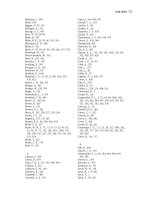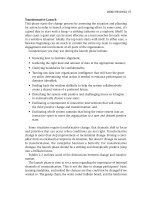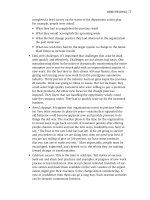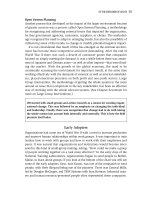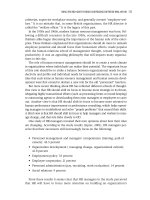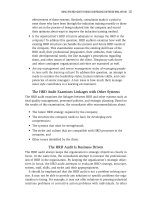Practicing Organization Development (A guide for Consultants) - Part 75 pps
Bạn đang xem bản rút gọn của tài liệu. Xem và tải ngay bản đầy đủ của tài liệu tại đây (316.31 KB, 13 trang )
Bickman, L., 346
Biech, 359
Biggart, N. W., 319
Billingsly, K., 323
Binzagr, G. F., 433
Bion, W., 83, 89–92
Blake, B., 367
Blake, R. R., 23, 95, 96, 185, 319
Blanchard, K. H., 408
Bliese, P., 421
Block, P., 47, 60, 69, 89, 258, 260, 357, 472
Blumberg, M., 322
Boots-Ebenfield, M., 562
Boss, W., 257, 416
Bouchez, J. P., 110
Boulding, E., 519
Boyatzis, A. R., 136
Bradburn, N., 141
Bradford, D., 169e
Bradford, L. P., 19, 20, 27, 88, 167e, 367,
378, 452
Brehm, J. W., 314, 315
Bridger, H., 367
Bridges, W., 358, 559
Bright, D., 556
Brinkerhoff, L., 5, 376
Brodbeck, P. W., 434
Brown, D., 108, 261
Brown, R., 607
Brown, S., 521
Browne, P. J., 621
Bruce, R., 241, 254, 257, 259, 268
Bruhn, J. G., 14
Bugental, J.F.T., 97, 601
Bunker, B. B., 94, 294, 426, 443
Burke, R. R., 317
Burke, W. W., 5, 15, 17, 18, 19, 25, 43, 53,
55, 56, 57, 73, 135, 138, 167e, 169e, 178,
185, 240, 242, 247, 255, 260, 313, 316, 319,
323, 354
Burns, T., 422
Bushe, G. R., 138
Byrd, D., 102
C
Cabana, S., 426
Cabral, D., 479
Cady, S. H., 5, 327, 333, 440, 454
Caldreis, F., 522
Callahan, D. M., 138
Cameron, K., 423
Campbell, J., 403
Cannella, A. A., 315
NAME INDEX 711
Capra, F., 66, 440, 470
Carnall, C. A., 323
Catcher, A., 89
Chaffee, E., 421
Chapman, J. A., 433
Charan, R., 431
Cherbeneau, J., 4, 160, 188, 473
Cherns, A., 429, 566
Chesterland, 426
Chisholm, R., 428
Cho, E. S., 481
Church, A. H., 135, 138, 160, 169e, 178, 281,
552, 558, 579, 629
Clardy, A., 18
Clark, L. P., 15, 317
Cobb, A., 255
Coch, J., 517
Coch, L., 86
Coffey, H., 97
Coghlan, D., 5, 426, 579
Cohen, S., 430
Cole, D., 167e
Collins, D., 39
Collins, J., 278, 279, 498, 532
Colteryahn, K., 1
Cooper, K., 136
Cooperrider, D. L., 5, 52, 64, 96, 169e, 184,
205, 276, 426, 444, 447, 450, 452, 510, 515,
523, 524, 531, 555, 556, 558
Corruzzi, C., 15
Costello, B. G., 106
Cotton, C. C., 621
Cottone, R., 497
Covey, S., 380, 382
Covin, T., 426
Crosby, B., 96, 102
Cummings, T. G., 1, 5, 23, 24, 112, 168e, 242,
252, 254, 277, 291, 319, 420, 421, 425, 427,
428, 429
Curtis, B., 116, 117
D
Daft, R., 430
Daniels, J. A., 138
Dannemiller, K., 5, 69, 184, 440, 444, 447,
452, 454
Darrow, C., 387
Darwent, C., 479
Daubman, K., 531
David, M. W., 116
Davis, K. J., 5, 467
Davis, P., 1
Davis, S., 98, 102
40_962384 bindex.qxd 2/3/05 12:22 AM Page 711
De Goffau, G., 429
De Leede, J., 429
Deal, T., 24
Deane, M., 97
Deming, J. E., 449
Devane, T., 294, 452, 474, 475
Devanna, M., 425
DeVogel, S. H., 475, 503, 507
Digh, P., 14
Dinkin, D., 15
Dirndorfer, W., 75
Donaldson, T., 496
Donlon, J. P., 479
Donovan, M., 138
Doucet, K., 15
Dougherty, 358
Drucker, P., 23, 378, 431, 510, 522
Dubois, D. D., 108, 135, 136
Dunfee, T., 496
Dunlop, J., 98
Dunnette, M., 403
Dutton, J. E., 522
Duvall, S., 433
Dyck, R., 434
Dyer, W. G., Jr., 5, 403
E
Eastman, K. K., 505
Egan, Father G., 102
Egan, T., 5, 266, 493, 505
Eggermont, S., 429
Einstein, A., 591
Eisen, S., 4, 5, 97, 98, 160, 178, 188, 260, 267,
473, 486, 583, 607
Eisenhardt, K., 521
Elkington, J., 474
Emery, F. E., 204, 346, 422, 426, 434, 444,
451, 452
Emery, M., 426, 517
Emory, C., 141
Eoyang, G. H., 5, 539, 540, 541, 543
Erickson, E., 378
Erikson, E., 83
Estrada, I., 531
Eubanks, J. L., 138
Everard, A., 15
Evered, R. D., 328
F
Fadil, P., 506
Fagenson, E. A., 317
Felton, D. F., 429
Ferguson, C., 97
712 NAME INDEX
Feyerherm, A. E., 5, 135, 138, 139, 154,
157, 420
Figallo, C., 574
Fink, N., 102
Fitz-Gibbon, C., 343
Follett, M. P., 92
Fombrun, C. J., 423
Foss, A., 5, 620
Frankel, M. S., 469, 498, 501, 503, 507
Fredrickson, X., 531
Freedman, A., 15, 247
Freiberg, J., 278
Freiberg, K., 278
French, J.R.P., 86, 246
French, R. P., 517
French, W. L., 19, 42, 103, 168e, 169e, 185,
242, 249, 252, 261, 317, 318, 323, 514
Freud, S., 82, 378
Freyerherm, A., 428, 497
Friedman, B., 118
Friedman, T. L., 479, 480
Fritz, R., 452
Frohman, A., 252
Fry, R. E., 510, 524, 531
G
Galbraith, J., 423, 430, 431
Gardner, H., 452
Gavin, D., 75
Gellermann, W., 5, 250, 266, 469, 493, 498,
501, 503, 507
Gersick, C., 406
Geyer, N., 95
Ghoshal, S., 431
Gibb, J., 20, 27, 89, 91, 378, 383, 386, 452
Gibbs, B. W., 138
Gilbert, M., 558, 579
Gioja, L., 541
Gobeli, D., 430
Goldsmith, M., 382
Goleman, D., 378
Golembiewski, R. T., 22, 89, 184, 323, 383, 621
Gomez-Mejia, L. R., 434
Gordon, R., 97
Gray, B., 428
Greiner, L., 247, 255, 266, 424
Griffin, P., 77, 499
Grub, L., 479
H
Hackman, J. R., 277, 452
Hafner, K., 551
Hagward, G. B., 138
40_962384 bindex.qxd 2/3/05 12:22 AM Page 712
Halal, W., 428
Hall, E., 473
Hall, M., 473
Halpern, N., 434
Hambrick, D. C., 315
Hamel, G., 278, 474, 513, 518, 520, 521, 523
Hammond, S., 531
Handy, C., 470
Hanna, D., 432
Harris, R. T., 256, 295, 297, 313, 327, 427
Harrison, M. I., 346
Harrison, R., 260
Harvey, D., 261
Harvey, J., 409
Hascall, J., 621
Head, T. C., 138
Hedrick, T. E., 346
Heifetz, R. A., 57
Henke, R., 561
Henschel, P., 562
Heraclitus, 10
Herena, M. R., 629
Herman, S., 101
Hersey, P., 408
Hershman, D., 651
Herzberg, F., 91, 93
Hester, P., 562
Heylighen, F., 13, 14
Higgin, B., 429
Hill, C., 421
Hitchin, D., 421, 427
Hofman, J. D., 75
Hofstede, G., 96, 473, 506
Holland, D., 17
Holman, P., 294, 452, 474, 475
Hooker, E., 97
Hornstein, H. A., 319
Houston, J. M., 258, 260, 266, 319
Huff, A. S., 521, 522
Hung, L.T.S., 15
I
Ichijo, K., 562
Imber-Black, I., 452
Isen, A., 531
J
James, H., 116
Jamieson, D. W., 4, 169e, 238, 240, 249, 250,
260, 267
Janis, I., 409
Janoff, A., 446, 451, 452
Janoff, S., 205, 444, 474, 517, 529
NAME INDEX 713
Janov, A., 650
Jaques, E., 367
Jayaram, G., 427
Jick, T., 74, 278, 433, 552
Jobs, S., 454
Johnson, 15
Johnson, B., 94
Johnson, G., 521
Johnson, L. B., 651
Jomon, M. G., 128, 131
Jones, D., 102
Jones, G., 421
Jones, R. M., 75
Jones, T. M., 505
Jongeward, D., 378
Jordan, M., 604
Joyce, W., 430
Jung, C., 82, 378
K
Kahn, R., 25, 40, 100
Kallejian, V., 97
Kanter, R. M., 20
Kaplan, S., 5, 550, 562, 565
Karimov, M., 481
Katz, D., 25, 40, 100
Katz, R., 407
Kazanas, H., 34
Kazanjian, R., 431
Kees Loose, J., 429
Kelley, 357
Kelly, K., 541
Kelner, H., 99
Kennedy, A., 24
Keppel, G., 346
Kerr, B., 380
Kerr, S., 278, 431, 433, 552
Kidder, R. M., 477
Kiesler, S., 522
Kilmann, R., 426
Kinnunen, G., 3
Klein, E., 387
Kleiner, A., 425, 443, 450
Kleiner, B. H., 17
Klemes, M., 97
Knowles, M., 452
Kohlberg, L., 505
Kolb, D., 252, 452
Koopman, C., 317
Kotter, J., 278, 425, 530
Kotter, J. P., 74
Kringas, P., 39
Kroeger, O., 102, 598
40_962384 bindex.qxd 2/3/05 12:22 AM Page 713
Kudray, L., 17
Kulick, O., 135
Kurland, N., 505
L
Lacy, M. Y., 621
Ladenson, R. F., 469, 498, 501, 503, 507
Lake, D., 118
LaMarke, S., 432
Lang, D., 40
Larson, E., 430
Lawler, E., 421, 432
Lawrence, P., 100, 422
Ledford, G., 421, 432
Legge, K., 323
Lens, W., 519
Lepsinger, R., 135
Levi, C., 100, 102
Levinson, D., 387
Levinson, M., 387
Lewin, K., 27, 75, 83, 85–89, 92, 95, 99, 103,
295, 303, 317, 367, 376, 378, 413, 443, 448,
450, 451, 517, 530
Lewis, M. J., 333
Likert, R., 30, 31, 367
Limbrick, V., 106
Lindaman, E., 444
Linder, R., 585
Lindholm, J., 141
Linstone, H., 190
Lipiec, J., 111
Lipnack, J., 551
Lippitt, G., 95, 135, 136, 138, 161, 247, 249,
258, 260, 367
Lippitt, R., 20, 27, 88, 91, 95, 96, 102, 103, 135,
136, 138, 139, 161, 178, 247, 249, 258, 260,
367, 378, 443, 444, 447, 451, 452
Lipsky, D., 5, 620
Lorsch, J., 100, 422
Lucia, A., 135
Ludema, J., 515, 523, 531
Luft, J., 587
Lundberg, C., 247
Lynton, R., 384, 385
M
Ma, Y Y., 604
Maas, P., 477
McBain, R., 106
McCann, J., 430
McClelland, 378
McDermott, L. C., 138
McDonah, J., 579
714 NAME INDEX
McGregor, D., 83, 92–94, 101, 367, 404
McIntire, S., 258, 260, 266
McIntire, S. D., 319
McKee, B., 387
Mackewn, 356
McLagan, P., 34
McLean, G. N., 3, 5, 43, 327, 338, 467, 474,
475, 480, 481, 485
McLean, L., 480
MacLean, T., 477
Macy, B., 421
Magyar, S. V., 14
Mankoe, I., 429
Manning, M. R., 433
Margulies, N., 245, 251, 252, 255, 260
Marrow, 378
Marty, M., 651
Maslow, A., 83, 94, 97
Massarik, F., 49, 318
Materana, U., 650
Mead, M., 88
Mento, A. J., 75
Metzger, R., 247, 255, 266
Meyer, D. E., 14
Michael, D., 188
Miles, M. B., 89, 319, 328
Miles, R., 431
Millemann, M., 541
Milliken, F., 522
Minahan, M., 22
Minno, D., 380
Minors, A., 499
Mintzberg, H., 518, 521
Mirabile, R., 135
Mirvis, 49
Mitchell, E., 470
Mitchell, K., 102
Mitchell, S., 559
Mitroff, I., 506
Mohr, B. J., 52, 53, 77, 240, 281, 426, 524
Mohrman, A., 421, 430
Mohrman, S., 421, 425, 430, 432
Moon, Y. L., 485
Morgan, G., 323
Morita, A., 212
Morris, L., 343
Mouton, J. S., 95, 96, 185, 319
Murray, H., 429
N
Nadler, 357
Nadler, D., 281, 298, 425, 510
Nadler, L., 33, 34, 47
40_962384 bindex.qxd 2/3/05 12:22 AM Page 714
Nakajima, A., 102
Neilson, E. H., 138
Nevis, E. C., 621
Newman, M., 424, 425
Ngyen, T. T., 433
Nielsen, 169e
Nieto Cardoza, E., 607
Nonaka, I., 562
Norton, J., 421
Novak, P., 382
Nowicki, G., 531
Nunnally, J., 140
Nuttin, J., 519
O
O’Driscoll, M. C., 138
O’Driscoll, M. P., 138
Oldham, G., 277
Oliver, D., 558, 579
Olsen, J., 102
Olson, E., 543
Olson, J., 628, 631, 637
Orlikowski, W. J., 75
Orr, A., 5, 620
Orr, B., 108
Oswald, R., 102
O’Toole, J., 316
Owen, H., 426, 444, 447, 451, 470, 474, 529
P
Page, M., 265, 506
Palmer, P., 651
Paquet, K., 558, 579
Pareek, U., 5, 113, 114, 118, 376, 384, 385, 398
Parker, R. A., 333
Partin, J. J., 138
Pascale, R., 541
Pasmore, W., 429
Passmore, W. A., 52
Pei-Carpenter, M., 49, 251, 318
Peters, M. B., 102
Peters, T., 24
Petrella, T., 89
Pfeffer, J., 278, 432
Polak, F., 519
Poling, D., 102
Pollack, A., 429
Porras, J. I., 278, 279, 324, 498, 536
Porter, M., 422, 512
Prahalad, C. K., 278, 474, 513, 518
Prescott, R., 12, 108
Preston, J. C., 138
Pringle, C. D., 322
NAME INDEX 715
Pritchard, W., 486
Purser, R., 426, 517
Putnam, R., 322
Q
Quade, K., 5, 77, 169e, 268, 607
Quinn, R., 169, 423, 425
R
Raia, A., 138, 154, 160, 178, 245, 252, 260
RainbowHawk, 470
Rao, T. V., 4, 106, 113, 114, 116, 118, 126
Raven, B., 246
Rea, L. M., 333
Rhinesmith, S. H., 479
Rice, A. K., 367
Ringland, G., 427
Roberts, C., 425
Robertson, C., 506
Robertson, P. J., 324
Rog, D. J., 346
Rogers, C., 83, 89, 97, 383
Romanelli, E., 424
Rosen, R., 14
Rosenthal, R., 322
Ross, R., 425
Ross, W., 421, 427
Roth, G., 425
Rothwell, W. J., 1, 4, 9, 12, 34, 39, 57, 106,
108, 135, 136, 141, 475, 544
Royal, K., 531
S
Sackman, H., 190
Sally, M., 116, 117
Sammut, A. C., 106
Sanderlands, L. E., 522
Sanders, E., 34
Sashkin, M., 90
Schaafsma, H., 75
Schein, E., 21, 24, 32, 57, 91, 168, 185, 242,
249, 252, 258, 365, 407, 408, 417
Schein, V., 255
Scherer, J. J., 4, 5, 81, 96, 102, 376, 383,
384, 390
Schindler-Rainman, E., 451
Schmuck, R. A., 319, 328
Schutz, W., 89, 383, 598
Scott, B., 5, 620, 621, 627, 639
Scott, W. R., 160
Seamon, T., 5, 620
Seashore, C., 394, 397
Seashore, E., 19, 167e
40_962384 bindex.qxd 2/3/05 12:22 AM Page 715
Seiling, J., 531
Sekerka, L., 531
Senge, P., 425, 470, 478
Sheats, P., 97, 410
Shepard, H., 89, 98, 102, 246, 367
Shepard, K., 138, 154, 160
Shepherd, H., 185
Singer, J., 433
Sirvastva, S., 184
Skarke, G., 17
Skinner, B. F., 82, 378
Slater, R., 278
Smendzuik-O’Brien, J., 5, 620
Smith, B., 425
Smith, D. M., 322
Smither, R. D., 258, 260, 266, 319
Snow, C., 428, 431
Snyder, W. M., 551, 555
Soper, J., 34
Sorensen, P. F., 52, 138
Spencer, J. L., 15
Sproull, L., 522
Sredl, H., 34
Srivastva, S., 52, 96, 427, 429, 515, 555
Stalker, G. M., 422
Stamps, J., 551
Starbuck, W., 522
Staw, B. M., 522
Stewart, J., 39
Stich, T., 261
Stimpert, J. L., 522
Stone, M. P., 452
Strebel, P., 15
Styhre, A., 434
Sudman, S., 141
Sullivan, R. L., 1, 3, 4, 9, 21, 39, 43, 102, 135,
139, 141, 154, 170e, 178, 180, 199, 475, 544,
628, 631, 637
Surface, C., 558, 579
T
Tannenbaum, R., 5, 19, 21, 77, 98, 139, 180,
199, 260, 267, 367, 383, 486, 489, 493, 494,
583, 607
Tavis, A., 5, 620
Taylor, F. W., 83, 85, 92, 513
Taylor, J. C., 429
Taylor, M., 12, 108
Thompson, H., 432
Thompson, L. L., 406, 409
Thuesen, J. M., 598
Tichy, N., 425
Towle, R., 106
Trist, E., 92, 367, 422, 429, 444, 446, 451, 452
716 NAME INDEX
Trompenaars, F., 473
Trosten-Bloom, A., 524
Tuckman, B. W., 406, 559
Turoff, M., 190
Tushman, M., 424, 425
U
Ulrich, D., 108, 115, 118, 278, 433, 552
V
Vaill, P., 205, 443
Van der Keijden, K., 427
Van Eijnatten, F., 429
Van Eron, A., 5, 73, 354
Van Eynde, D., 135
Varney, G. H., 24, 135, 138, 154, 170e, 178, 627
Verkerk, M., 429
Von Bertalanffy, L., 100, 452
Von Krogh, G., 562
Vowen, M., 452
Vygotsky, L., 448
W
Waclawski, J., 281, 552, 579
Wadowski, J., 138
Walterman, B., 441
Walton, A. E., 322
Walton, R., 432
Wanous, J., 46
Warner, S., 106
Warrick, D. D., 138, 164, 168e, 178, 271,
278, 279
Waterman, R., 24, 441, 442
Watkins, J. M., 52, 53, 77, 170e, 184, 240, 281,
426, 524
Watson, I., 584–585, 587
Weick, K. E., 478, 527
Weidner, C., 135
Weinberg, G., 397
Weisbord, M. R., 85, 90, 92, 93, 185, 205,
257, 278, 444, 446, 451, 452, 474, 512, 517,
528, 529
Weiss, A., 4, 211, 237
Welbourne, T. M., 434
Welch, J., 511, 533
Wenger, E., 551, 555
Weschler, I., 97
Wheatley, M., 5, 77, 440, 452, 470, 486, 646
White, L. P., 265, 506
Whiteley, A., 75
Whitney, D., 52, 447, 450, 515, 524, 531, 555
Wigglesworth, D., 486
Wilbur, K., 470
William, E. H., 116, 117
Wilson, H., 506
40_962384 bindex.qxd 2/3/05 12:22 AM Page 716
NAME INDEX 717
Y
Yaeger, T., 52
Yeager, S., 323
Yeoell, M., 395
Yetmar, S. A., 505
Yeung, A. K., 115
Yon, B., 102
Young, X., 531
Z
Zackrison, R. E., 15, 247
Zahn, L., 561
Zajac, G., 14
Wilson, L., 506
Wilson, T., 367
WindEagle, 470
Winfrey, O., 604
Wissman, D., 5, 620
Woodman, 170
Woods, C., 5, 620
Wooten, K. C., 265, 506
Worley, C. G., 1, 4, 19, 23, 24, 112, 135, 138,
139, 154, 157, 160, 167e, 168e, 178, 188, 242,
252, 254, 277, 291, 319, 421, 427, 497, 544
Wright, L., 108
Wyman, S., 241, 254, 257, 259
40_962384 bindex.qxd 2/3/05 12:22 AM Page 717
HOW TO USE THE CD-ROM
SYSTEM REQUIREMENTS
PC with Microsoft Windows 98SE or later
Mac with Apple OS version 8.6 or later
USING THE CD WITH WINDOWS
To view the items located on the CD, follow these steps:
1. Insert the CD into your computer’s CD-ROM drive.
2. A window appears with the following options:
Contents: Allows you to view the files included on the CD-ROM.
Software: Allows you to install useful software from the CD-ROM.
Links: Displays a hyperlinked page of websites.
Author: Displays a page with information about the Author(s).
Contact Us: Displays a page with information on contacting the publisher or author.
Help: Displays a page with information on using the CD.
Exit: Closes the interface window.
If you do not have autorun enabled, or if the autorun window does not appear, follow these
steps to access the CD:
1. Click Start ➪ Run.
2. In the dialog box that appears, type d:<\\>start.exe, where d is the letter of your
CD-ROM drive. This brings up the autorun window described in the preceding set
of steps.
3. Choose the desired option from the menu. (See Step 2 in the preceding list for a
description of these options.)
IN CASE OF TROUBLE
If you experience difficulty using the CD-ROM, please follow these steps:
1. Make sure your hardware and systems configurations conform to the systems
requirements noted under “System Requirements” above.
2. Review the installation procedure for your type of hardware and operating system.
It is possible to reinstall the software if necessary.
To speak with someone in Product Technical Support, call 800–762–2974 or 317–572–3994
M–F 8:30 a.m. – 5:00 p.m. EST. You can also get support and contact Product Technical
Support through our website at www.wiley.com/techsupport.
Before calling or writing, please have the following information available:
• Type of computer and operating system
• Any error messages displayed
• Complete description of the problem.
It is best if you are sitting at your computer when making the call.
41_962384 cdrom.qxd 2/3/05 12:22 AM Page 718
Pfeiffer Publications Guide
This guide is designed to familiarize you with the various types of Pfeiffer publications. The
formats section describes the various types of products that we publish; the methodologies
section describes the many different ways that content might be provided within a product.
We also provide a list of the topic areas in which we publish.
FORMATS
In addition to its extensive book-publishing program, Pfeiffer offers content in an array of
formats, from fieldbooks for the practitioner to complete, ready-to-use training packages that
support group learning.
FIELDBOOK Designed to provide information and guidance to practitioners in the midst of
action. Most fieldbooks are companions to another, sometimes earlier, work, from which its ideas
are derived; the fieldbook makes practical what was theoretical in the original text. Fieldbooks can
certainly be read from cover to cover. More likely, though, you’ll find yourself bouncing around
following a particular theme, or dipping in as the mood, and the situation, dictate.
HANDBOOK A contributed volume of work on a single topic, comprising an eclectic mix of
ideas, case studies, and best practices sourced by practitioners and experts in the field.
An editor or team of editors usually is appointed to seek out contributors and to evaluate
content for relevance to the topic. Think of a handbook not as a ready-to-eat meal, but as a
cookbook of ingredients that enables you to create the most fitting experience for the occasion.
RESOURCE Materials designed to support group learning. They come in many forms: a com-
plete, ready-to-use exercise (such as a game); a comprehensive resource on one topic (such as
conflict management) containing a variety of methods and approaches; or a collection of like-
minded activities (such as icebreakers) on multiple subjects and situations.
TRAINING PACKAGE An entire, ready-to-use learning program that focuses on a par-
ticular topic or skill. All packages comprise a guide for the facilitator/trainer and a workbook
for the participants. Some packages are supported with additional media—such as video—or
learning aids, instruments, or other devices to help participants understand concepts or practice
and develop skills.
• Facilitator/trainer’s guide Contains an introduction to the program, advice on how to
organize and facilitate the learning event, and step-by-step instructor notes. The guide also
contains copies of presentation materials—handouts, presentations, and overhead designs,
for example—used in the program.
42_962384 bob.qxd 2/3/05 12:25 AM Page 719
• Participant’s workbook Contains exercises and reading materials that support the learn-
ing goal and serves as a valuable reference and support guide for participants in the weeks
and months that follow the learning event. Typically, each participant will require his or
her own workbook.
ELECTRONIC CD-ROMs and web-based products transform static Pfeiffer content into
dynamic, interactive experiences. Designed to take advantage of the searchability, automation,
and ease-of-use that technology provides, our e-products bring convenience and immediate
accessibility to your workspace.
METHODOLOGIES
CASE STUDY A presentation, in narrative form, of an actual event that has occurred inside
an organization. Case studies are not prescriptive, nor are they used to prove a point; they are
designed to develop critical analysis and decision-making skills. A case study has a specific time
frame, specifies a sequence of events, is narrative in structure, and contains a plot structure—
an issue (what should be/have been done?). Use case studies when the goal is to enable partic-
ipants to apply previously learned theories to the circumstances in the case, decide what is
pertinent, identify the real issues, decide what should have been done, and develop a plan of
action.
ENERGIZER A short activity that develops readiness for the next session or learning event.
Energizers are most commonly used after a break or lunch to stimulate or refocus the group.
Many involve some form of physical activity, so they are a useful way to counter post-lunch
lethargy. Other uses include transitioning from one topic to another, where “mental” distancing
is important.
EXPERIENTIAL LEARNING ACTIVITY (ELA) A facilitator-led intervention that moves
participants through the learning cycle from experience to application (also known as a Structured
Experience). ELAs are carefully thought-out designs in which there is a definite learning pur-
pose and intended outcome. Each step—everything that participants do during the activity—
facilitates the accomplishment of the stated goal. Each ELA includes complete instructions for
facilitating the intervention and a clear statement of goals, suggested group size and timing,
materials required, an explanation of the process, and, where appropriate, possible variations to
the activity. (For more detail on Experiential Learning Activities, see the Introduction to the
Reference Guide to Handbooks and Annuals, 1999 edition, Pfeiffer, San Francisco.)
42_962384 bob.qxd 2/3/05 12:25 AM Page 720
GAME A group activity that has the purpose of fostering team spirit and togetherness in addi-
tion to the achievement of a pre-stated goal. Usually contrived—undertaking a desert expedition,
for example—this type of learning method offers an engaging means for participants to demon-
strate and practice business and interpersonal skills. Games are effective for team building and
personal development mainly because the goal is subordinate to the process—the means through
which participants reach decisions, collaborate, communicate, and generate trust and under-
standing. Games often engage teams in “friendly” competition.
ICEBREAKER A (usually) short activity designed to help participants overcome initial anx-
iety in a training session and/or to acquaint the participants with one another. An icebreaker
can be a fun activity or can be tied to specific topics or training goals. While a useful tool in
itself, the icebreaker comes into its own in situations where tension or resistance exists within
a group.
INSTRUMENT A device used to assess, appraise, evaluate, describe, classify, and summarize
various aspects of human behavior. The term used to describe an instrument depends primarily
on its format and purpose. These terms include survey, questionnaire, inventory, diagnostic,
survey, and poll. Some uses of instruments include providing instrumental feedback to group
members, studying here-and-now processes or functioning within a group, manipulating group
composition, and evaluating outcomes of training and other interventions.
Instruments are popular in the training and HR field because, in general, more growth can
occur if an individual is provided with a method for focusing specifically on his or her own behav-
ior. Instruments also are used to obtain information that will serve as a basis for change and to
assist in workforce planning efforts.
Paper-and-pencil tests still dominate the instrument landscape with a typical package com-
prising a facilitator’s guide, which offers advice on administering the instrument and interpreting
the collected data, and an initial set of instruments. Additional instruments are available
separately. Pfeiffer, though, is investing heavily in e-instruments. Electronic instrumentation
provides effortless distribution and, for larger groups particularly, offers advantages over paper-
and-pencil tests in the time it takes to analyze data and provide feedback.
LECTURETTE A short talk that provides an explanation of a principle, model, or process
that is pertinent to the participants’ current learning needs. A lecturette is intended to estab-
lish a common language bond between the trainer and the participants by providing a mutual
frame of reference. Use a lecturette as an introduction to a group activity or event, as an
interjection during an event, or as a handout.
42_962384 bob.qxd 2/3/05 12:25 AM Page 721
MODEL A graphic depiction of a system or process and the relationship among its elements.
Models provide a frame of reference and something more tangible, and more easily remembered,
than a verbal explanation. They also give participants something to “go on,” enabling them to
track their own progress as they experience the dynamics, processes, and relationships being
depicted in the model.
ROLE PLAY A technique in which people assume a role in a situation/scenario: a customer
service rep in an angry-customer exchange, for example. The way in which the role is approached
is then discussed and feedback is offered. The role play is often repeated using a different
approach and/or incorporating changes made based on feedback received. In other words, role
playing is a spontaneous interaction involving realistic behavior under artificial (and safe)
conditions.
SIMULATION A methodology for understanding the interrelationships among components
of a system or process. Simulations differ from games in that they test or use a model that
depicts or mirrors some aspect of reality in form, if not necessarily in content. Learning occurs
by studying the effects of change on one or more factors of the model. Simulations are com-
monly used to test hypotheses about what happens in a system—often referred to as “what if?”
analysis—or to examine best-case/worst-case scenarios.
THEORY A presentation of an idea from a conjectural perspective. Theories are useful because
they encourage us to examine behavior and phenomena through a different lens.
TOPICS
The twin goals of providing effective and practical solutions for workforce training and orga-
nization development and meeting the educational needs of training and human resource
professionals shape Pfeiffer’s publishing program. Core topics include the following:
Leadership & Management
Communication & Presentation
Coaching & Mentoring
Training & Development
e-Learning
Teams & Collaboration
OD & Strategic Planning
Human Resources
Consulting
42_962384 bob.qxd 2/3/05 12:25 AM Page 722
What will you find on pfeiffer.com?
• The best in workplace performance solutions for training and HR professionals
• Downloadable training tools, exercises, and content
• Web-exclusive offers
• Training tips, articles, and news
• Seamless on-line ordering
• Author guidelines, information on becoming a Pfeiffer Affiliate, and much more
Discover more at www.pfeiffer.com
42_962384 bob.qxd 2/3/05 12:25 AM Page 723
